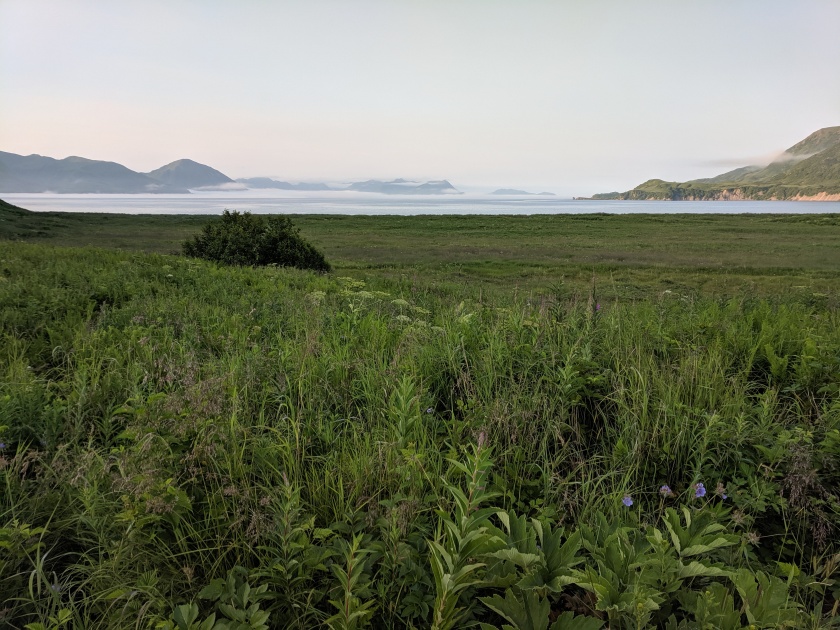
It has been an amazing field season on Kodiak! I had the pleasure of participating in two different projects – the OHAHP and a joint Alutiiq Museum/Koniag Inc. project at Karluk Lake – and now feel like a bona fide Kodiak archaeologist.
Following the project at Karluk Lake in June (which you can read about here), the rest of the Seattle-based field team arrived and we travelled to Old Harbor to initiate excavation at KOD-114, an ancestral village on Sitkalidak Island. In the Alutiiq language, this village is called Ing’yug, while Russian colonists and explorers called it Ezopkinskoe. Ing’yug was inhabited by Sugpiaq/Alutiiq ancestors when the Russian fur trader Grigorii Shelikhov arrived in the Kodiak Archipelago in 1784. Subsequent ethnohistoric documentation comes from Russian explorer Yuri Lisiankski, who visited the village in 1805. While a broad written history of Russian colonialism on Kodiak exists, those accounts are often written from the perspective of the colonizer and lack the details of daily life in Sugpiaq/Alutiiq villages during this period of culture contact, resistance, persistence and change. That’s where the archaeology comes in! By studying the materials (i.e. houses, tools, food remains, toys, trash, etc.) that Sugpiaq/Alutiiq ancestors left behind, archaeologists can get a complementary, and perhaps fuller, picture of how those ancestors lived through this period of history.
With that in mind, our 2019 OHAHP team set several goals at the start of the field season for our work at Ing’yug:
- locate houses and middens (trash piles)
- map the extent of the village site
- collect some artifacts and fauna (animal remains) for analysis
- determine dates of occupation for the village

Overall, these goals were met. (More posts to come about each of the activities mentioned below!)
- We dug a total of 15 test pits and one trench in order to identify houses with intact stratigraphy and look for diagnostic artifacts that could confirm the age of the site.
- We collected and documented a sample of animal remains and a few artifacts from the site.
- We made drawings of the stratigraphy in several of our test pits to better understand what activities may have led to those strata being deposited over time.
- We made a map of the houses and other structures visible on the surface using a compass, a couple 50-meter tapes and a low-tech surveyor’s tool called a transit.

While the stratigraphy (i.e. layers in the soil, both naturally and culturally formed) was largely intact where we dug, we also noticed evidence of pot-hunting across the site. Pot-hunting is destructive to archaeological sites, not only because cultural material is lost, but because information about the location and context of artifacts in relation to other objects, houses and the site overall, are also lost. It’s like losing pieces to a jigsaw puzzle – a jigsaw puzzle that is already missing pieces due to natural processes like erosion and decomposition that occur over time – making it harder to see the whole picture.

We found an abundance of evidence of Sugpiaq/Alutiiq residence at the village of Ing’yug in the form of charcoal-rich layers in the soil, shells and animal bones left over from meals, and a literal ton of fire cracked rocks. What we didn’t find were many artifacts, which surprised us given the extent of the trash piles, or middens. I’ll discuss this more in another post.

The dearth of artifacts means that estimating dates for the site was impossible in the field, however, we did collect wood charcoal samples, which can be dated using radiocarbon, and shells from the midden, which have growth rings like trees that make it possible to use them for dating. Hopefully these or other dating methods can provide some clarity of timing, so that we can place Ing’yug within the wider story of Sugpiaq/Alutiiq ancestors across the Kodiak Archipelago and beyond.
Stay tuned for more posts about the archaeology of Ing’yug, camping on Sitkalidak and visiting Awa’uq, a refuge rock that Shelikhov attacked when he arrived on Kodiak in 1784.

Great post! If you can edit, you might change “We dug… one trench across the site…” so it does not get misread as ‘a trench that spans the site.’ Otherwise don’t worry about it. Looking forward to additional posts. Ben
LikeLike